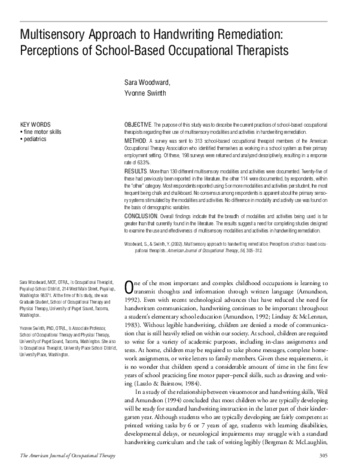I used the multisensory approach for intervention planning with several clients. At the beginning of my fieldwork I knew about some multisensory applications, but I did not have a full understanding of the multisensory approach. I had to research various applications of the multisensory approach. I was unable to find a single study that isolated the multisensory approach (Woodward & Swinth, 2002). I did, however, find a wealth of resources devoted to its numerous applications. I included these multisensory approaches in my interventions. These activity ideas guided my interventions. I also did a research study comparing a multisensory intervention to a gross motor intervention, as well as how each approach affected handwriting legibility. I still incorporated a preparatory activity and handwriting for 10-15 minutes in my study. Research by Woodward and Swinth (2002) guided my intervention planning and improved my ability to work on just multisensory activities to strengthen my study. I used this study with two of my clients to guide my intervention planning.
I gained knowledge and self-confidence by researching in my spare time. I also gained confidence by actually implementing a study at the Clark County School District and developing my own PICO question for research. I thought this experience was beneficial and it has taught me the skills to continue to implement evidence-based practice when I am practicing as an occupational therapist in the future. I realized that I must be intentional to incorporate evidence-based practice, and I need to keep developing this as a future practitioner. Researching the multisensory approach was difficult because there isn’t much research that isolates multisensory activities. I enjoy learning, and am always excited to learn about different interventions and their effectiveness to become be the best practitioner I can be.
References
- Woodward, S., & Swinth, Y. (2002). Multisensory approach to handwriting remediation: Perceptions of school-based occupational therapists. American Journal of Occupational Therapy, 56 (3), 305–312. doi: 10.5014/ajot.56.3.305
